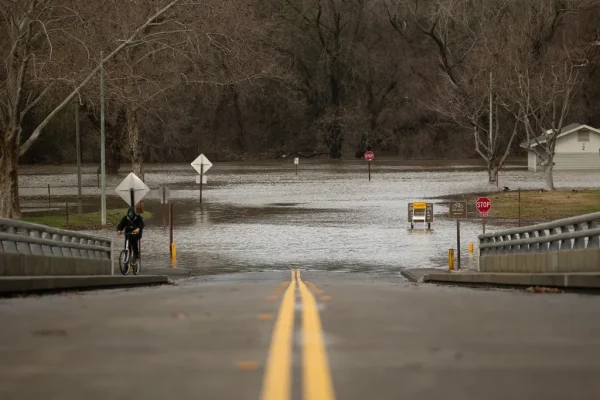

A dozen days of wet and wild weather haven’t ended the drought, and won’t cure the driest period in the West in the past 1,200 years.
The year 2023 began with a historic bang — record precipitation and disastrous flooding throughout much of California. Parched watersheds soaked up the first rains, but soon became waterlogged. Runoff accelerated. Sodden hillsides collapsed. Rural levees burst and rivers spilled their banks. Towns went underwater. People died.
Meanwhile, the Pacific Ocean continued to whip up more atmospheric rivers and “bomb cyclones,” and one after another, these intense storms pummeled California. Abruptly, a state emerging from the dust of three painfully dry years was inundated with more water than it knew what to do with.
But the wet and wild weather over the past dozen days won’t end the drought, at least not yet, and it won’t undo the driest period in the West in the past 1,200 years.
About 71% of California was experiencing “severe” drought on Wednesday, dropping to 46% today, according to the National Integrated Drought Information System. That designation is based on a long list of complex metrics, including soil moisture, water shortages, levels of streams and lakes, snow cover and runoff. The storms also come at a time when scientists are predicting a long-term shift toward a warmer, drier climate.
With at least two more storms approaching California over the next week, we look at what all this means for drought conditions and water supply.
Sorry, the drought isn’t over
In some places, it might feel like the drought is history. Take San Francisco. Its water supply — Hetch Hetchy Reservoir, in the Sierra Nevada — is 80% full, the ground is saturated and near-record rainfall has occurred in recent days.


“Drought is in the eye of the beholder,” said Jeffrey Mount, senior fellow at the Public Policy Institute of California. “If you’re in San Francisco, and you rely on surface storage from Hetch Hetchy, this is great … But if you’re in a small town in the San Joaquin Valley, where massive pumping of groundwater has dried out your well, it will take successive years of rain like this to make a difference.”
The San Joaquin Valley’s groundwater basins, where thousands of wells have run dry, are just one example of drought impacts that can take years to reverse. California’s aquatic ecosystems are another. Drought has harmed a variety of fish species, and it will take years for them to rebound. Some, like Delta smelt and winter-run Chinook salmon, are endangered and, faced with an array of human-induced stressors, probably never will recover.
Determining when a drought begins and ends is tricky. While many experts refer to California’s 2013-2016 drought, as though it had a clear beginning and an end, others, like Mount, feel that particular drought hasn’t yet ended — the current drought is just an extension of it.
After all, most years in the past 15 have produced an underwhelming amount of rainfall. Since the big water year of 2006, only three — 2011, 2017 and 2019 — have been notably wet. Many climate experts believe California’s predominant weather pattern in the future will be one of steady drought conditions broken periodically by very wet interludes.
“This might well be just another case of a wet year followed by a string of dry ones,” Mount said.
Reservoir levels rising
Water is rapidly flowing into the state’s reservoirs.
Lake Oroville — the largest reservoir of the State Water Project, with a capacity of 3.5 million acre feet — was 28% full in early December and now is just shy of 50%. That’s an increase of 700,000 acre-feet, and experts predict it could rise by almost 500,000 more before February. (Each acre-foot is enough to support two or three families for a year.) Still, Oroville and most of the state’s other major reservoirs remain mostly empty.
TELL YOUR FRIENDS ABOUT CITIZENS JOURNAL Help keep us publishing –PLEASE DONATE



